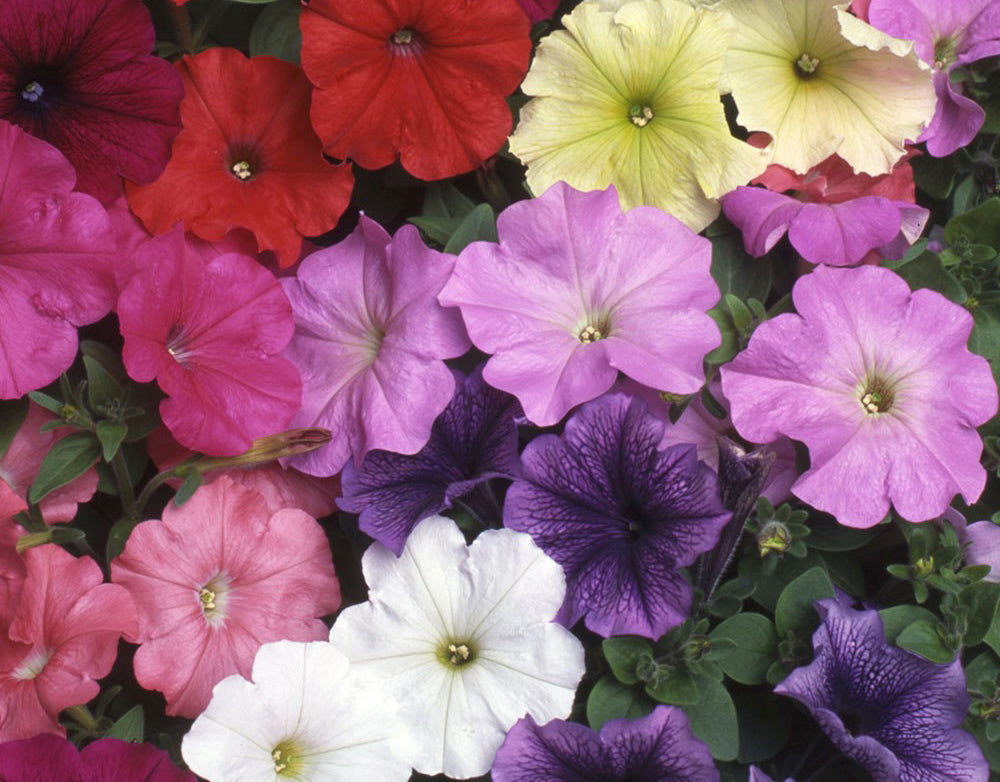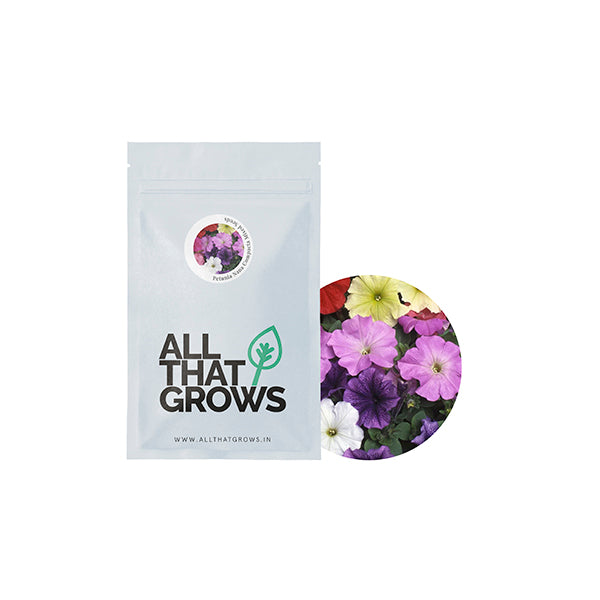



- SOWING
TIMEMar- August (Plains), March to May (Hills)
- Sowing
Distance8-12 inches between rows
- Fruit
WeightN/A
- Fruit
ShapeN/A
- Days to
maturity55-75 days from transplanting
- Details
- How to sow
- Reviews
Petunia is a type of flowering plant that belongs to the family of nightshades.There are 35 species of petunia that originate from South America. Petunias are low-growing, bushy to spreading tender perennials usually grown as annuals. Their soft, thick leaves are slightly sticky to the touch. Trumpet-shaped flowers have a single set of plain-edged petals, or can be doubled, ruffled, or fringed and come in colors from light pink through dark red, and pale blue through deep purple. Petunia cultivates in areas that provide at least 5 to 6 hours of sun per day, on a well-drained, fertile soil. It doesn't tolerate frost. Petunias are cultivated because of their ornamental flowers that are available in variety of colors and shapes. Whether in hanging baskets or containers on tables or a front porch, growing petunias in pots brings out vibrant color throughout the summer to whatever area you choose.
Planting instructions
Soil should be collected in a garden pot mixed with well rotten cow dung or manure.
Broadcast the seeds over the soil bed and cover it with a thin layer of sieved sand to allow germination.
Maintain a distance of 1.0 feet between the plants.
Sprinkle little water and then as per requirement keeping the soil moist.
Flowering starts after 45-50 days post transplant which continues for 100-120 days depending on the variety.
Growing Requirements
pests
Marigolds are susceptible to damping off (Rhizoctonia solani) and pests like collar rat, Sclerotium rolfsii, Botrytis cinerea, Powdery mildew and cucumber mosaic. The major symptom for these pests is light brown spots on the lower leaves or on early seedlings. To prevent these diseases, ensure proper drainage and ventilation and avoid over watering.
soil
Sandy loamy soil with pH 5.6 to 6.5 is ideal for its cultivation.
spot
Place in a spot that receives either full sun or partial sunlight.
temperature
20-25°C
watering
Regular watering keeps the flowers healthy. You can use a water can or a water spray.
how to harvest
For harvesting marigold, loose flowers are plucked when they attain full size depending upon the variety. Flowers should generally be harvested in the morning hours. Irrigation of soil with water,before plucking, gives better flower quality. Also, plucking of flowers regularly and removal of dried flowers enhances the yield.

Customer Reviews
The productiveness of any seed we sell is subject to your local climatic conditions*, the sowing method you adopt, and your commitment to the planting process. We give no warranty, expressed or implied, and are in no way responsible for the produce.
Please note that all our seasonal recommendations/ sowing information is as per the local climatic conditions. *For more information on the optimum conditions required for growing seeds in your region, please contact us at, hello@allthatgrows.in or Whatsapp us at, +91 8544865077
Questions & Answers
Have a Question?
Be the first to ask a question about this.




Petunia Nana Compacta Mixed Seeds
Seed Type : Non-Hybrid, Open Pollinated and Non-GMO
Plant Height : Grows up to 1.5 high
Flower Shape: Funnel shaped flowers with oval petals
Colour : Multicolored
Specifications : Long flowering period, Suitable for cut flowers.
Petunia is a type of flowering plant that belongs to the family of nightshades.There are 35 species of petunia that originate from South America. Petunias are low-growing, bushy to spreading tender perennials usually grown as annuals. Their soft, thick leaves are slightly sticky to the touch. Trumpet-shaped flowers have a single set of plain-edged petals, or can be doubled, ruffled, or fringed and come in colors from light pink through dark red, and pale blue through deep purple. Petunia cultivates in areas that provide at least 5 to 6 hours of sun per day, on a well-drained, fertile soil. It doesn't tolerate frost. Petunias are cultivated because of their ornamental flowers that are available in variety of colors and shapes. Whether in hanging baskets or containers on tables or a front porch, growing petunias in pots brings out vibrant color throughout the summer to whatever area you choose.
Seed Type : Non-Hybrid, Open Pollinated and Non-GMO
Plant Height : Grows up to 1.5 high
Flower Shape: Funnel shaped flowers with oval petals
Colour : Multicolored
Specifications : Long flowering period, Suitable for cut flowers.
- SOWING
TIMEMar- August (Plains), March to May (Hills)
- Sowing
Distance8-12 inches between rows
- Fruit
WeightN/A
- Fruit
ShapeN/A
- Days to
maturity55-75 days from transplanting
Planting instructions
Soil should be collected in a garden pot mixed with well rotten cow dung or manure.
Broadcast the seeds over the soil bed and cover it with a thin layer of sieved sand to allow germination.
Maintain a distance of 1.0 feet between the plants.
Sprinkle little water and then as per requirement keeping the soil moist.
Flowering starts after 45-50 days post transplant which continues for 100-120 days depending on the variety.
Growing Requirements
pests
Marigolds are susceptible to damping off (Rhizoctonia solani) and pests like collar rat, Sclerotium rolfsii, Botrytis cinerea, Powdery mildew and cucumber mosaic. The major symptom for these pests is light brown spots on the lower leaves or on early seedlings. To prevent these diseases, ensure proper drainage and ventilation and avoid over watering.
soil
Sandy loamy soil with pH 5.6 to 6.5 is ideal for its cultivation.
spot
Place in a spot that receives either full sun or partial sunlight.
temperature
20-25°C
watering
Regular watering keeps the flowers healthy. You can use a water can or a water spray.
how to harvest
For harvesting marigold, loose flowers are plucked when they attain full size depending upon the variety. Flowers should generally be harvested in the morning hours. Irrigation of soil with water,before plucking, gives better flower quality. Also, plucking of flowers regularly and removal of dried flowers enhances the yield.



 Sign In
Sign In








